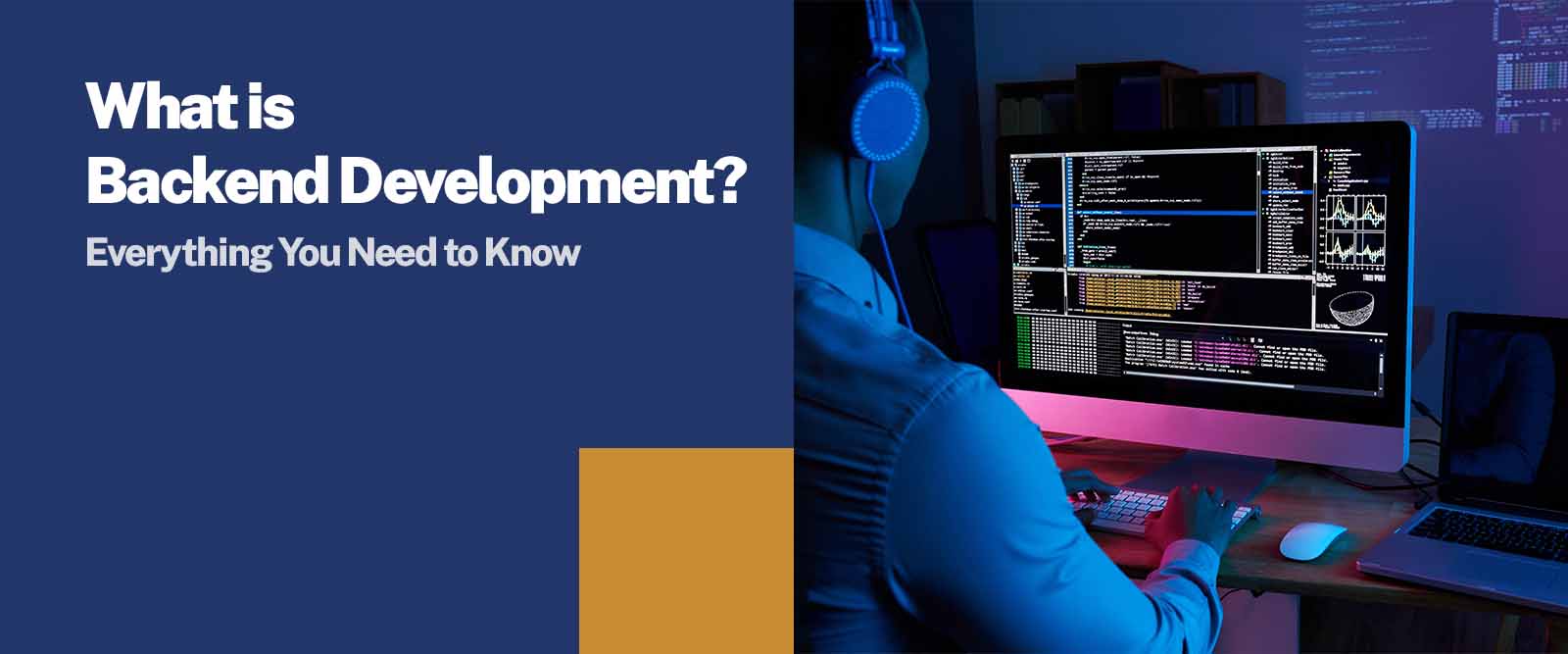5800 students unlocked their dream jobs with UG/PG programs in top colleges. Apply Now!
Backend development is a crucial aspect of web and mobile application development that involves creating and maintaining the server side of applications. With the rapid growth of the digital economy in India, the demand for skilled backend developers is on the rise. In this blog, we will provide a comprehensive overview of backend development, its importance in application development, and the skills required to become a backend developer in India.
To become a backend developer, you must possess specific qualifications and skills. An MCA degree or a B.Tech/B.E. degree in computer science can help you become a backend developer, although some companies may consider candidates with equivalent experience.
Now, let us understand backend development meaning and its importance in the digital world.
What Is Backend Development?
Backend development is the process of building and maintaining the server-side components of a web or mobile application. It involves creating the underlying logic and infrastructure that powers the application, including databases, APIs, and server-side scripting. Backend developers work closely with front-end developers to ensure the application's seamless integration between the client and server.
The primary focus of backend web development is the server side of an application, including how it handles client requests, stores data in databases, and executes server-side logic. Backend developers work with programming languages such as Java, Python, PHP, and web development frameworks such as Django, Flask, and Express.js.
Some of the critical tasks that a backend developer performs include server administration, database management, API design, server-side scripting, and debugging. Additionally, they must be proficient in software engineering principles, design patterns, and algorithms.
Backend Developer - Roles And Responsibilities
Backend developers in India are responsible for designing, developing, and maintaining the server-side components of web and mobile applications. Here are some of the typical roles and responsibilities of a backend developer in India:
Server-side backend programming - Backend developers write server-side code to handle client requests, process data and manage server resources. They work with programming languages such as Java, Python, PHP, etc.,
Database management - Backend developers design and manage databases that store application data. They ensure the databases are optimised for speed, scalability, and security.
API design and development - Backend developers design, develop, and maintain APIs allowing applications to communicate. They ensure the APIs are reliable and scalable.
Server administration - Backend developers manage server infrastructure, ensuring servers are optimised for performance, scalability, and security.
Debugging and troubleshooting - Backend developers identify and resolve bugs, errors, and performance issues on an application's server side.
Software engineering principles - Backend developers adhere to modularity, reusability, maintainability, and scalability to ensure the application's robustness and quality.
How To Pursue A Career In Backend Development?
In India, MCA degree is one of the most popular courses for students who wish to pursue a career in backend development. The MCA course is important, for it provides an in-depth understanding of programming, database management exposure, web development frameworks, and software engineering principles.
Backend Development : Eligibility
The eligibility criteria for MCA may vary depending on the institution, but generally, the following requirements are necessary:
Educational Qualifications - Applicants must hold a Bachelor's degree in computer science or a related field, with a minimum aggregate score of 50% in their undergraduate studies. Some institutions may also accept candidates with a Bachelor's degree in any discipline, provided they have studied mathematics at the 10+2 level.
Entrance Exams - Many institutions in India require applicants to clear entrance exams such as NIMCET, MAH MCA CET, or BIT MCA for admission to their MCA programs.
Work Experience - While not mandatory, some institutions may prefer applicants with relevant work experience in computer science or software development.
Backend Development: Admission Process
The admission process for the Master of Computer Applications (MCA) program in India typically involves the following steps:
- Clear the relevant entrance exam.
- Fill out the application form for the chosen institution.
- Appear for the admission process with the original documents.
- Participate in the group discussion and personal interview if required.
- Based on the declared merit list, if selected, get your documents verified, and pay the requisite fees.
The admission process to the MCA program in India may vary depending on the institution. Therefore, it is important for candidates to carefully research the eligibility criteria and admission process of their chosen institution and prepare accordingly to increase their chances of success.
Top MCA Colleges In India
Some of the top MCA colleges in India are:
|
College Name |
Average Fees (INR) |
Admission Process |
|
Birla Institute of Technology, Jaipur |
5,55,000 |
10+2 with 60% + BITSAT |
|
ITM University, Gwalior |
2,27,000 |
Entrance (JEE Main) and Merit-Based |
|
MNNIT Allahabad |
3,29,000 |
10+2 with 60% + JEE Main and JEE Advanced |
|
NIT Rourkela |
- |
10+2 with 60% + JEE Main and JEE Advanced |
|
NIT Surathkal |
2,61,000 |
10+2 with 60% + JEE Main and JEE Advanced |
|
NIT Trichy |
2,75,000 |
10+2 with 60% + JEE Main and JEE Advanced |
|
PSG College of Technology, Coimbatore |
1,74,000 |
10+2 with 50% + TNEA |
Skills Required To Become A Backend Developer In India
To become a successful backend developer in India, you need to possess several skills, including:
Backend coding skills - You need to have a strong foundation in programming languages, such as Java, Python, etc., to build server-side applications.
Database management - You should be familiar with various databases, such as MySQL and MongoDB, and be able to create and manage complex databases and backend for web development.
API design and development - You should be able to design and develop APIs that allow the front-end and backend of the application to communicate with each other.
Understanding backend development frameworks - You should be familiar with popular web development frameworks, such as Django, Flask, Node.js, Express.js, etc.,
Server administration - You should have a basic understanding of server administration, including how to set up and maintain a server and deploy applications.
Career Prospects For Backend Development In India
The field of backend development in India offers a range of job roles with varying responsibilities and salaries. Here are some of the different job roles in the backend development field in India.
Backend Developer - A backend developer writes server-side code, manages databases, develops and maintains APIs, and troubleshoots server-side issues. The average salary is ₹7.35 lakhs.
Full Stack Developer - A Full Stack Developer is a professional who can work on both the front-end and back-end of a web or mobile application. The role of a Full Stack Developer in India includes designing and developing complete applications, from the user interface to server-side components, and managing databases and APIs. The average salary is ₹6 lakhs. Read more about Full Stack Developer Salary.
DevOps Engineer - A DevOps engineer manages the server infrastructure and deployment process, ensuring seamless integration between development and operations. The average salary is ₹6.64 lakhs.
Java Developer - A Java Developer is a professional who specialises in developing applications using the Java programming language. Java Developers are responsible for designing, implementing, and maintaining Java-based applications, troubleshooting issues, and ensuring software quality. The average salary is ₹4.85 lakhs.
Software Engineer - A Software Engineer specialised in backend development work on the design, development, testing, and maintenance of server-side components and databases, along with APIs and other integrations. The average salary is ₹6.75 lakhs.
Conclusion
Backend development is an integral part of the web and mobile application development process, and the demand for skilled professionals in this field is constantly increasing in India. With the rapid growth of the tech industry in India, backend development is a promising and rewarding career choice, providing ample opportunities for growth and development. With the right education and training from reputed education service providers such as Sunstone, developers can gain the skills and knowledge necessary to design, develop, and maintain high-quality applications. It will lead to a more fulfilling career and ensure they can meet the demands of an increasingly competitive job market.
FAQ - Backend Development
What is the difference between front-end and back-end development?
Front-end development is concerned with the user interface and presentation of a website or application, including the design, layout, and functionality of the components that users interact with. This typically involves working with technologies such as HTML, CSS, and JavaScript, and using tools such as design software, text editors, and front-end frameworks.
On the other hand, back-end development focuses on the server side of a website or application, dealing with the data storage, processing, and communication between the server and the front-end. This involves working with programming languages such as Python, Ruby, or Java, and using tools such as databases, APIs, and back-end frameworks.
Is full-stack development better than backend development?
It's not necessarily true that full-stack development is better than backend development.
Full-stack development involves working with both the front-end and back-end of a website or application and requires a diverse set of skills and knowledge. On the other hand, backend development deals with the server side of a website or application. Backend developers are responsible for data storage, processing, and communication.
In some cases, full-stack developers earn less than backend developers, but that also depends on the project and the company.
HELP
Take the first step towards your dream job.
ABOUT THE AUTHOR


